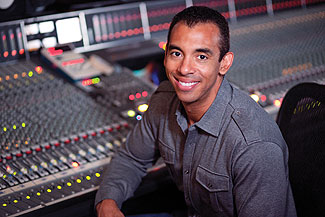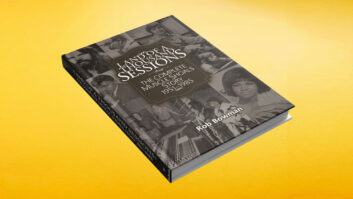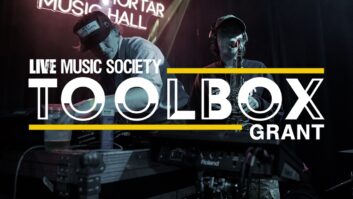
Harvey Mason Jr.’s new domain is the former Track Records facility in North Hollywood
Photo: Dabling Harward
North Hollywood’s Track Records, built in 1980 by producer Brian Ahern for his then-wife Emmylou Harris, is under new ownership. In early 2008, the facility — one of the last to be constructed during the golden age of L.A. rock studios, and the birthplace of memorable hits from Jane’s Addiction to Maroon 5 — was renovated by A-list writer/producer Harvey Mason Jr., who upgraded the two-building complex and renamed it Mason Sound. Since then, it’s been the site for all of his projects, with such clients as Jennifer Hudson, Britney Spears, Leona Lewis and Whitney Houston.
Harvey Mason Sr., a jazz drummer and longtime member of Fourplay, was signed to Arista while I was doing West Coast A&R at the label in the late ’70s and early ’80s, and it’s cool that Harvey Jr. is now working with Clive Davis, just as his dad once did. They worked together on two tracks for Houston’s comeback album, I Look to You, meeting during Davis’ frequent visits to L.A. in his bungalow at the Beverly Hills Hotel. “Clive still gives as much input as ever,” says Mason Jr., sitting alongside his wife, Jeannine Sharp, on a leather couch in one of the studio’s comfortable lounges.
The younger Mason practically grew up in studios before dedicating himself to basketball. At the University of Arizona, he played for legendary coach Lute Olson on a team that made it to the 1988 Final Four before blowing out his knee. Fortunately, he had another elevated skill set, and soon after graduation began his career in music. More recently, Mason Jr. combined his two loves, producing the LeBron James feature documentary More Than a Game and executive producing the soundtrack out on his own Harvey Mason Music, a joint venture with Interscope. Much of the work was done right here.
The retired Olson and several of Mason Jr.’s Arizona teammates attended the movie’s premiere the weekend before I visited, and Sharp says her husband is “still coming down from his big night. That project was his baby.”
He began working at Mason Sound in early 2008 after spending six months on the renovation, “getting it to feel right,” says Mason Jr.. Common areas were stripped down to the walls and studs — but recording spaces were left intact. The earth tones of the décor evoke Track Studios’ retro vibe while feeling thoroughly contemporary.
Mason Jr. and Sharp give me a quick tour, first upstairs, which boasts a roomy, well-appointed lounge with a recess in the wall just big enough for him to stretch out his long frame and crash or chill out and watch TV on the flat screen. “It’s my private spot,” he says.
We descend the stairs and head down the long hallway — its walls covered with rows of Mason Jr.’s Gold and Platinum records — to Studio B. Aside from some tasteful cosmetic touches and a major main speaker system overhaul, B is essentially unchanged from its original state, though the previous owners installed a late-model, 80-channel SSL 9000J in the 20×21-foot control room, adjacent to a righteously old-school 30×40×18 tracking room, which was recently used to record strings and a choir for the soundtrack.
Down the hall in Studio A, the first thing that catches my eye is the looming row of four brown lacquer custom Augspurger subs spread across the floor in front of the glass separating the control room from what was formerly the recording space, which Mason Jr. has converted into a weight room as well-stocked with iron as Gold’s Gym. Between those honkin’ woofers and the stacks of weights, the feeling of power is palpable.
“This is where I am most of the time,” says Mason Jr.. “Every record comes through here, writing-wise and track-wise. When I finish, we mix in B.” Gone is the E Series SSL that formerly dominated the room. A is now a state-of-the-art Pro Tools workspace. Mason is running Pro Tools 7.3 and Logic 8 on a pair of Mac G5s, along with a third G5 for throwing down quick mixes.
One of his most in-demand skills is producing vocals, and he has a tried-and-true methodology of recording singers. “I’ve been using a Sony 800G since 2000,” he says. “It’s a really clean, simple microphone that’s very true. It doesn’t have any crazy boost on the high or the low; what you put into it you get back. I like my vocals to be pretty bright, but the high end on the Sony is very smooth. I find that some of the vintage mics aren’t transparent enough on the high end for my taste. I’ve been using an Avalon M5 mic pre since day one, and usually a Summit TLA100 compressor. That’s the magic formula — and if you tell everybody that, I may be out of work,” he says with a smile.
“Mix-wise,” he continues, “I use a bunch of vintage gear like Neves for EQ, UREIs for compression and several TC Electronic 3000s that I use at times for reverb.”
Mason Jr. continued to produce and write high-level projects while shepherding the More Than a Game film project through the Hollywood gauntlet, and then creating the soundtrack from scratch. This guy is obviously a multitasker.
“I’ve got a big head — I wear a lot of hats,” he deadpans, and Sharp laughs knowingly. “We’ve been together for 23 years,” he points out.
“Harvey expects to be here for a long time,” says Sharp, looking completely at home in their spiffy new crib. It’s gratifying to see such an important piece of L.A. recording history in such good hands and being put to such good use.






